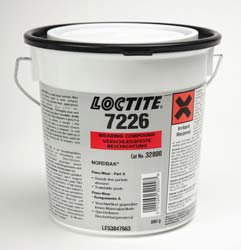
Posted to News on 18th Apr 2013, 21:34
Composites help pump repairs to deliver rapid payback
Loctite ceramic-reinforced polymer composites have been used by Eriks in a pump refurbishment project, leading to an increase in pump efficiency of 30 per cent that will be worth almost 20,000 to the end user over a five-year period.

Loctite polymer composites protect parts against attack. These ceramic-reinforced epoxies extend the life of new components and restore the worn surfaces of old ones. They create a sacrificial and renewable working surface, protecting the structural integrity of the original substrate.
Pumps are typical of equipment whose life can be extended and high performance assured by efficient predictive maintenance and repair. Castings, impellers and volutes wear due to corrosion, erosion, cavitation and mechanical damage, and all can be effectively repaired with the Loctite range.
A major UK automotive manufacturer provides an excellent illustration of what can be achieved. To demonstrate potential gains, Eriks suggested evaluating the efficiency of one of the company's pumps that handles process water in the metalwork pre-treatment process prior to body coating. This 22kW ELPO pump was put to test at Eriks' Electro-Mechanical Services (EMS) workshop in Southampton and it was found to be under-performing by a minimum of 30 per cent against the manufacturer's original test data.
Repair process
The unit was then dismantled and all components examined for wear. The pump was found to be heavily corroded and the impeller worn, burred and imbalanced. In addition, the mechanical seal had seized and the pump was out of alignment with the motor. The volute was also cut-water worn, the bearings showed evidence of fretting and corrosion, and the motor was not inverter-rated.
All components that required coating with Loctite polymer composites were first steam cleaned to remove any residues and salts, and then bead-blasted to achieve a surface roughness of 75 microns. Loctite 7515 was used to pre-treat the substrates to prevent corrosion and improve adhesion between the metal parts and the polymer composites.
Next, Loctite 7117 was applied as a 'hold coat' to smooth the surface imperfections and provide a key for the thicker layers that were required to return the pump to its original dimensions. A 'build coat' of Loctite 7226 was used to replace the metal work away through years of use and create a tough surface that would be resistant to future wear.
In common with others in the range, this Loctite compound offers distinct advantages over traditional repair methods such as hard metal welding or flame spraying, both of which are difficult and costly to apply to large surfaces. In contrast, Loctite 7226 is easily applied on all surface sizes and offers the extra benefit of corrosion protection. Also, it does not create any heat stress during its application.
Loctite 7226 is one in a family of protective coatings and compounds used by Eriks; it is a trowelable and non-sagging epoxy that in this case was chosen for its ability to protect against abrasion from fine particles. The range provides a choice of grades for fine through to coarse particles, and there are also specific products for pure chemical attack, corrosion protection and high impact.
Temperature resistance across the range typically extends from -30 up to 120degC but there are also special grades that can be used up to 230degC. Overall, the products provide good protection against fresh and sea water, ammonium sulphate and sodium hydroxide.
Reassembly and test
Following the application of Loctite 7226, another coat of Loctite 7117 was applied to achieve a very smooth finish to reduce friction within the pump and improve its energy efficiency. The pump was then fitted with new bearings, oil seals and mechanical seals. The impeller was dynamically balanced, the pump reassembled and a new 22kW high-efficiency motor fitted. The motor and pump were then fitted to the bedplate and laser aligned.
A second performance test was then performed and the results were outstanding. The remedial work had restored the pump to original specification, increasing its efficiency by 30 per cent. The cost of the repair amounted to 5542 but, offsetting this, in the first year alone the reduction in energy consumption was calculated to be 3936 (assuming 0.08/kWh at 12 hours per day with an 80 per cent load).
The Enhanced Capital Allowance (ECA) scheme, a Government incentive for investment in energy-saving equipment, also enabled the automotive manufacturer to reclaim 585.90. So, with all the savings taken into account, the cost of the pump repair was just 685. Of course, substantial savings will continue to be made that will far outweigh this cost.
Savings
It has also been calculated that the end user will reduce carbon emissions by 28 tonnes, save 51.90MWh of energy and, over a five-year period, this will be worth 19,680, just for the one pump. Needless to say, the company is now evaluating the potential energy savings that could result from more pumps receiving the Loctite treatment from Eriks.
Follow the link for more information about Loctite repair products.
Want the latest machine building news straight to your inbox? Become a MachineBuilding member for free today >>

















